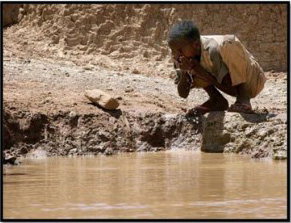Safe, clean drinking water is the most essential element to living a healthy lifestyle and yet so many of us take it for granted. Next time you open a tap to pour yourself a glass of clean water, spare a thought for the millions of people who do not have access to uncontaminated drinking water. Only 57% of Sub-Saharan Africa is covered by water versus a world average of 82% and deforestation, pollution and agricultural activities in African countries  have led to the further shrinking of water resources. Taking into account that not all available water sources meet the recognised and accepted water quality standards for human consumption, it is obvious to see just how many people, particularly in rural Africa, go without one of the most basic components to health. The 2006 African Water Development Report puts the number of people who are without access to clean drinking water at a staggering one billion.
have led to the further shrinking of water resources. Taking into account that not all available water sources meet the recognised and accepted water quality standards for human consumption, it is obvious to see just how many people, particularly in rural Africa, go without one of the most basic components to health. The 2006 African Water Development Report puts the number of people who are without access to clean drinking water at a staggering one billion.
Some of the worst affected individuals are a generation of children and toddlers. Adequate hydration is essential to the development of a healthy child and influences their weight, future risk of chronic diseases as well as attention span. In poverty stricken areas, the effects of dehydration in children are exacerbated by the risk of contracting water-borne diseases in contaminated water. The African Water Development Report of 2006 states that in 1998 72% of all reported cholera cases globally were in Africa while other organisations report that 30 000 children die each day from complications of drinking contaminated water, and 85% of illnesses in African children under the age of 5 are caused by water borne pathogens. These water borne diseases result in an estimated 443 million school days lost annually through absenteeism and are a major stumbling stone to education in developing Africa. Basic education has the power to lift individuals and communities out of the cycle of poverty, so one wonders what the knock-on effect would be by simply providing a source of safe drinking water in schools. Allowing children and their family’s access to water from schools would eliminate the hours children spend walking to the nearest tap to collect clean water and allow more time for schooling and study.
